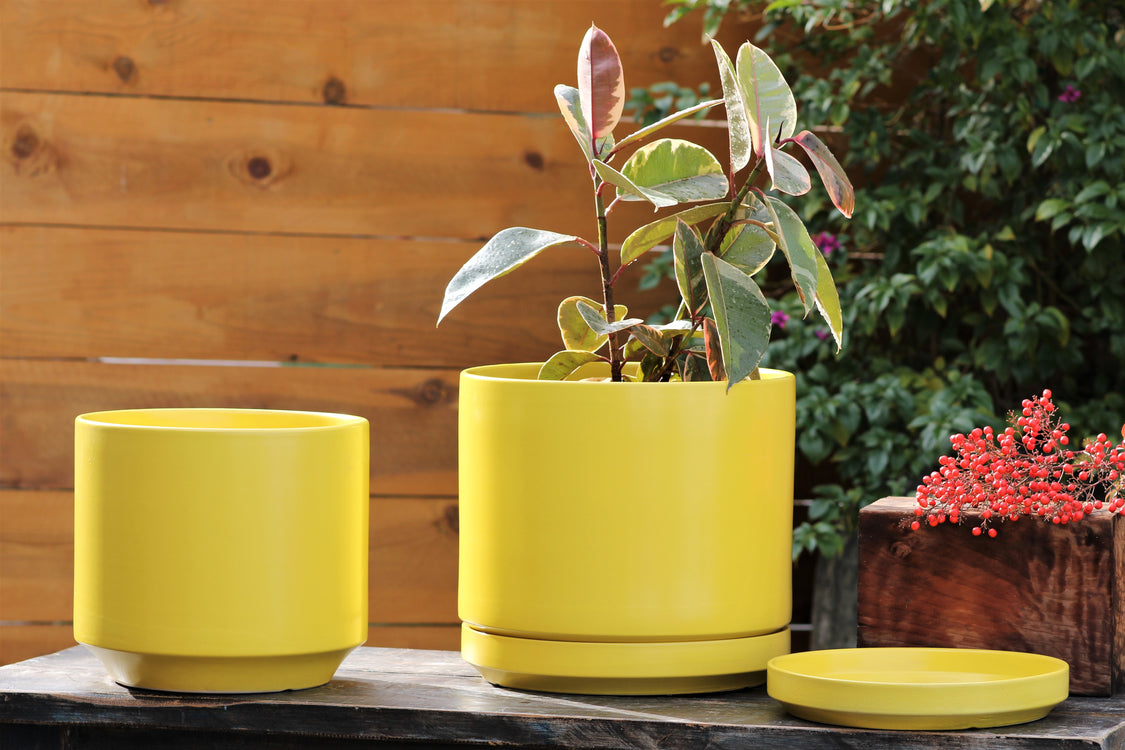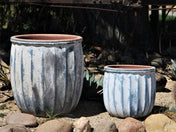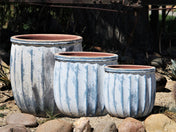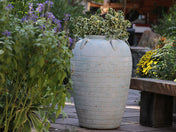The right indoor planter balances the look and also nourishes the plant. At Plantatorem, we recommend choosing such indoor ceramic plant pots that would go with your decor and suit your plant's requirements. Your planter should be large enough, drain well, and match your room's style (color, shape, material).
This blog answers all kinds of indoor planter questions, so you can confidently choose pots for indoor plants. We will also cover a few of our best-sellers so you don’t have to take the hassle of finding ceramic pot for plants indoors. So, let’s get started...
How Do I Find the Right Indoor Planter Size?
Healthy plants need the right pot size. For small to medium plants, you can step up by 1–2 inches in diameter, and for bigger plants, by 2–3 inches. A 4-inch plant can migrate to a 5-6″ pot, while a 12-inch plant can go to a 14-15″ pot.
Going big can also cause damp soil, limited drainage, and root rot. That’s why, always give enough room for growth in the pot when matching the root ball.
Mid Modern Planter With Detached Saucer
On the other hand, tiny succulents or herbs thrive in small pots. Whereas tall or bushy plants need large ones. Our Mid Modern Planter with Detached Saucer series (10″, 12″, and 14″ diameters) fit shorter plants, mid-size leaves, and large interior trees too. To keep moisture & prevent stunting, use an indoor planter pot that is a little bigger than the plant's existing container.
Why Should Indoor Planters Have Drainage Holes and Saucers?
Indoor plant pots need good drainage most. Water should exit so roots can access oxygen; wet soil kills plants. Choose planters with drainage holes. We’ve come up with an idea of our own too.
To use a planter without a hole, try it as a cachepot by placing the plant in a smaller drainage pot. By watering the inner pot, then draining it, it would hydrate regularly.
Another reason is, planters with saucers or trays capture runoff to clean surfaces. For this reason, our mid-century contemporary planters have removable saucers. That saucer keeps floors and furniture dry while the drainage hole works.
An indoor flower pot with a drainage hole and saucer/tray makes watering safe and healthy. Use the saucer to empty water after watering. This easy method protects plants and homes.
Which Materials are Best for Indoor Planters?
Watering frequency, plant health, and style depend on planter material. Ceramic, terracotta, plastic/fiberglass, metal, and others are common.
Glazed ceramic indoor planter pots are popular. They're beautiful and keep moisture better than clay. Clay pots air effectively, evaporating moisture and promoting root aeration. Terracotta pots dry out rapidly and may need more watering because clay is permeable. You may get many modern indoor plant pots made of high-fired, durable ceramic.
Glazed ceramic indoor planter pots are popular. They're beautiful and keep moisture better than clay. Clay pots air effectively, evaporating moisture and promoting root aeration. Terracotta pots dry out rapidly and may need more watering because clay is permeable. You may get many modern indoor plant pots made of high-fired, durable ceramic.
Other materials like plastic, fiberglass, metal, wood, and decorative materials are also present. Untreated wooden planters look natural but may warp. Metal planters, especially black or brass ones, are stylish but can sear roots in direct sunlight. Concrete or stone indoor garden containers have an industrial vibe but are weighty. Fiberglass or plastic are good for weight or indoor/outdoor adaptability.
If a ceramic pot for indoor plants lacks a drainage hole, use an inner pot. Good drainage (or a saucer) and matching your room's design can make all these materials suitable for indoor plant containers.
How Do I Make Space for Large Indoor Plant Pots and Planters?
Large indoor pots are great for big plants or dramatic plants. Fiddle-leaf figs, palms, and many plants need big indoor plant pots or planters to accommodate their root systems. Oversized pots become art in themselves.
For instance, the 14" diameter Mid Modern Large Planter with Detached Saucer offers adequate space for tall plants and a versatile minimalist design. Check out these few pointers that would help you to make some space:
- A planter stand may elevate tall planters, enhance drainage and circulation and protect your floor.
- Standing pots bring plants to eye level and provide a trendy layered effect.
- A neutral modern indoor plant pot on a wooden pedestal gives height and sophistication to your décor.
- Ceramic or stone planters, especially large ones, are heavy, so ensure sure the floor or stand can support them.
- Multiple pots can create an indoor garden or gallery. You can choose like the Small Modern Planter with Detached Saucer.
- Place a huge planter next to a smaller one indoors or use a collection of pots of varied heights.
- Create a lush nook or “plant corner” in your home with this layered method.
Remember that huge planters need drainage and saucers. Plantatorem's large indoor planters and pots are stylish and functional, accommodating a variety of plants.
So, Ready to Buy Your First Indoor Garden Pot from Plantatorem?
The perfect indoor planter depends on size, drainage, material, and style. Choose the proper size for roots to grow without overwatering the soil. Choose a planter with a drainage hole or an inner pot with a tray and a detachable saucer to protect your surfaces. Choose a material like ceramic pots that are classic and moisture retentive.
Finally, coordinate your planter to your room decor. White pots make flowers stand out, while gray/cream planters are minimalist. Cacti and succulents prefer porous clay pots, while tropical palms prefer larger ceramic planters.
At Plantatorem, we recommend considering functions and design too. Check your plant's size, light needs, and watering habits to choose the right indoor plant pot. Happy planting!










